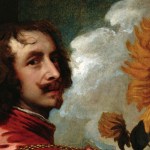I admit that I’ve caught myself scrolling social media feeds more than usual during some of my time of confinement.
Although I know scrolling is not the best way to spend my time, it is refreshing to see people posting more creatively than ever. They are creating fun videos with families, sharing the art of song, doing painting demonstrations, and even bedazzling their face masks. It is fascinating what an effect the power of art can have during periods of hardship and uncertainty. If you feel bad not finishing that painting you started long ago or never got to your daily drawing routine, now is the best time to do it and share it with the world.
One of the greatest masters, Flemish artist Anthony van Dyck, became the leading court painter in England after he created a series of his best work during 6 years in quarantine during the black plague in Palermo.
In 1624, van Dyck was quarantined shortly after arriving in Palermo because of the plague outbreak, which is still one of the worst in Italy’s history. He spent his time creating a series of paintings of Palermo’s patron saint, St. Rosalia. His response to the mass amount of suffering was to offer solace through what he knew best: art.

Van Dyck was a student of Peter Paul Rubens and became a 17th-century Flemish Baroque artist who specialized in religious, mythological, and portrait painting. He traveled extensively throughout Europe studying and making art. In 1621 his life took a turn when he went to Italy, little did he know he would remain there for the next six years.
One has to imagine van Dyck, a foreigner, in the midst of this: On a day like any other, van Dyck travels from Genoa to Palermo to participate in some type of artistic activity or endeavor. He enters Palermo ready to get to work only to find out that a plague is devastating the city. He considers leaving because of the danger. It most likely would not have been difficult for him to find a way out of Palermo since he was affiliated with Rubens, who was not only an artist but a diplomat, and he was also at one time a court painter to King James I. In other words, van Dyck had connections.
There was still work to be done in Palermo, however, and van Dyck was not afraid to do it. He set up a studio practice in the middle of the plague and continued to make work for his patrons. People were asking for paintings of portraits and religious subjects if only to remember their loved ones and deepen their faith amidst their suffering.
Then comes the news that remains were found in a nearby cave, and they are authenticated as St. Rosalias. All of Palermo enters a religious frenzy. The people begin to pray to the saint for help. It’s difficult for me to imagine that van Dyck, as a foreigner, isn’t watching this unfold in a detached way, somewhat scared, somewhat confused, and somewhat intrigued.
St. Rosalia was a young girl who was led from her home by angels to live in a cave so she could practice her love for God. In the cave, she performed a type of asceticism to conquer the desires of her flesh and become one with God. She would later die in that cave.
Legend has it that St. Rosalia appeared to a sick woman and a hunter during the plague that broke out in Palermo in 1624. She revealed to the hunter where her remains were to be found in the cave and asked that he carry her remains in procession around the city. The hunter found the cave and her remains and did as she asked. Once he finished, the plague stopped and St. Rosalia became the patron saint of Palermo.
The subject matter of the commissions suddenly change. Instead, patrons want paintings of St. Rosalia, and they approach van Dyck to do the job. The problem, however, is that there isn’t a reference for what St. Rosalia looks like. Van Dyck himself was taken by his deepened faith, hurriedly but diligently getting to work referencing his sketchbook in which he, during his travels, documented the work of those before him.
Van Dyck constructs a face, body, and attire from imagination using his prior experiences, mind, and heart as his guide as he also had no access to models during the quarantine. He understands the significance of this endeavor. The city has come together in its love of this saint. Van Dyck must do her appearance and her story justice.
Van Dyck spends the next several years painting St. Rosalia. In “St. Rosalia Interceding for the City of Palermo,” Van Dyck depicts St. Rosalia in her cave casting a pleading look into the light from above. Her remains are on the ground next to her and she gestures to the city, Palermo, behind her.
In “Saint Rosalia Intervening for the Plague-Stricken of Palermo,” Van Dyck depicts St. Rosalia elevating into heaven. Cherubs surround her and carry her into the light from above. One of the cherubim holds her remains in its hand and another holds her coronation crown. She looks into the light but gestures to the city below, Palermo.
In “The Coronation of St. Rosalia,” Van Dyck depicts St. Rosalia in heaven where she meets the Virgin Mary and a baby Jesus upon their throne. St. Rosalia, dressed in golden fabric over her red robe, kneels to accept her crown from the hands of Jesus. On the ground next to her lie her remains and some lilies which signify her pure love of God.
These paintings were more than just illustrations of a story. St. Rosalia is depicted as connected to or as an intermediary for Palermo in all of these paintings. These paintings served as an intermediary between people and their God; they were a physical manifestation of prayer and hope. People looked to these paintings not to say, “That sure is good! He sure can paint!” but because they felt their lives depended on them.
I can imagine Van Dyck finishing a painting and sees people prostrate before it, tears in their eyes, love, and hope in their hearts and realizes that art is much more than him: its power is beyond what he can understand. When he sees the reaction of people to what he created, it’s hard to believe that he is not also moved to tears with love and hope in his heart. Shortly thereafter, the plague leaves the city of Palermo.
The plague hit its height during the Renaissance in Europe, and the Renaissance occurred, in part, as a response to that destruction. Though we now endure hard times as COVID-19 spreads around the world, it is necessary to remember that art is powerful in providing relief, comfort, hope, and love. Whether it’s exploring creativity on social media or contemplating masterfully done works, art can provide a connection to something deep in ourselves as we struggle through our existence; and it has the potential to carry us forward into what we will become.



Leave A Reply